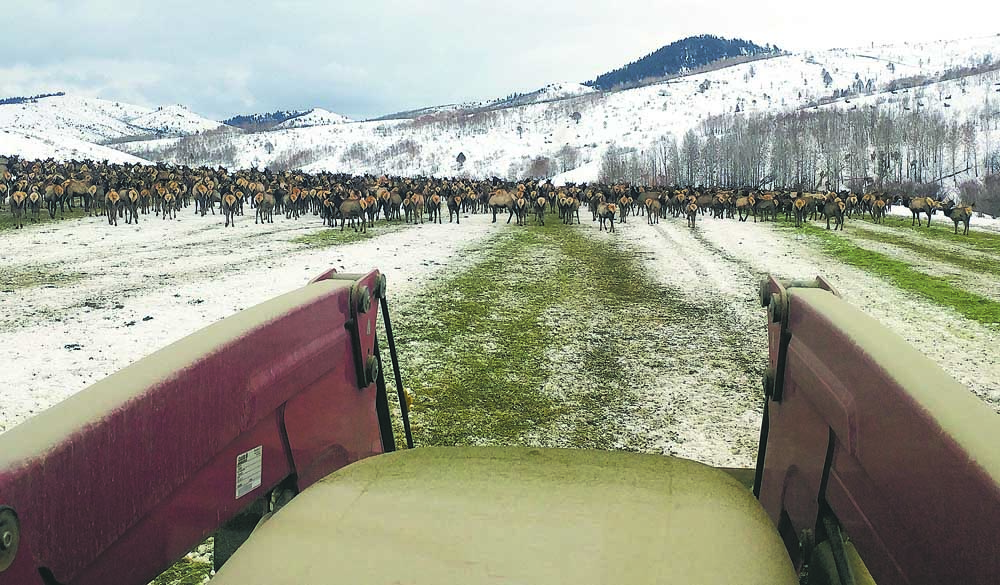Keeping elk out of trouble in Idaho’s Tex Creek area
Published 5:52 am Thursday, June 8, 2017

- An estimated 6,500 animals spend winter in the Tex Creek Wildlife region. Feeding was done to prevent depredation on agricultural areas by elk. (Photos courtesy Waco Wease)
Emergency big game feeding in Eastern Idaho’s Tex Creek Wildlife Management Area this winter was done in order to keep elk out of trouble.
Idaho Fish and Game spokesman Gregg Losinski said from that perspective the feeding program that brought thousands of tons of hay to keep elk off of private land was a success. Mule deer had it tougher, mostly because the animals don’t respond as well to feeding programs, and suffered higher than normal winter mortality. Very few elk succumbed to winter mortality.
“Overall in this region elk starving was never an issue,” Losinski said. “We wanted to get out feeding so the elk stayed off farmers’ hay.”
Regional habitat manager Rob Cavallaro said, in the fall, workers captured and collared about 29 deer — mostly fawns — and checked back on them after the winter. He said of those collared, 90 percent died during the winter, pointing to a dire outcome for the mule deer population.
The estimated 4,000 elk in the Tex Creek range fared well despite worries of depredation to private land. But Fish and Game employees have a lot of work cut out for themselves in the coming years.
The extensive feeding was necessary after the Henry’s Creek Fire burned 22,000 acres in the wildlife management area, much of the burn hitting key winter ranges. The region hosts an estimated 6,500 big game animals in winter. Those animals are now spreading out to the Caribou and Palisades ranges for the summer.
Cavallaro said the department is developing a five-year plan for the 34,000-acre wildlife management area that includes seeding and transplanting nursery grown sagebrush and shrubbery to the fire-ravaged region.
Some natural growth has started this spring, including choke cherries popping up from the dirt. But the sagebrush habitat was hit hard. Another concern is the threat of cheatgrass overtaking the area, since it spreads relentlessly and quickly in fertile burned areas. The dry, thin grass is good fire fodder and can choke out better natural growth that deer need to feed on. Cavallaro said early aerial seeding helped keep cheatgrass from spreading. He said there are some patches of cheatgrass on the drier slopes in the area, but transplanted shrubbery should hopefully take over.
“We made a lot of effort to get some aerial seeding done, even over the snow,” Cavallaro said. “The big challenge remains as far as vegetation to restart the shrubs that are gone … it will take years to get them back, but we’ll get a jump start this fall.”
The $350,000 price tag for the feeding program was paid for by emergency supplemental appropriation granted by the Idaho Legislature and Fish and Game’s winter feeding account. That account is paid for by sportsmen and women, with 75 cents of every big game hunting tag going into that account.
Beginning in early December, crews started feeding the elk herds up to 15 tons of nutrient-dense hay daily.
Fat supplies in deer and elk help the animals maintain themselves through winter when food is scarce and foraging requires more energy. But heavy snowpack paired with the devastating fire would have spelled doom for area farmers’ winter wheat and hay stores if Fish and Game hadn’t intervened. Cavallaro said at the start of winter, Fish and Game employees had to haze some elk herds off private land before intensive feeding was underway.
“Once we got going on feeding it seemed to go pretty smoothly,” Cavallaro said.
The department hired three local ranchers to distribute the hay daily — even on weekends and holidays — to keep the elk off private land. Cavallaro thanked the volunteers and hired workers that were dedicated enough to snowmobile into the backcountry and distribute hay.
“The impetus of this was really to be responsible to our agricultural neighbors,” Cavallaro said.
Roads into Tex Creek opened at the typical April 15 date. But all the roads were closed this winter compared to previous years when some of the roads were open. Motorized recreation and antler shed searches have not been hindered by the fire. Fish and Game offered a special big game hunt in October with 500 antlerless deer tags and 500 antlerless elk tags for sale. The controlled special tags were designed to harvest more animals since the habitat could not sustain the winter herds.
A video showing one of the feeding projects offers an expansive look at the long line of elk plodding along a track of hay delivered by volunteers and workers.
A February Fish and Game news release said dozens of sportsmen and several landowners volunteered to deliver the feed.
Fish and Game has never delivered this much feed. But the twin problems of a harsh winter and extensive fire made the unprecedented feeding necessary to keep elk off private land.
Cavallaro said workers have begun canvassing the wildlife management area this spring to spot where growth is occurring and where seeding will be needed. The fire burned especially hot beneath some of the juniper and aspen trees, so the blackened earth has yet to host new growth.
“We want to improve the habitat as soon as possible, but it’s going to take some time,” Cavallaro said. “We can’t just say ‘We survived the winter we’re done,’ this will be ongoing for years to come.”






